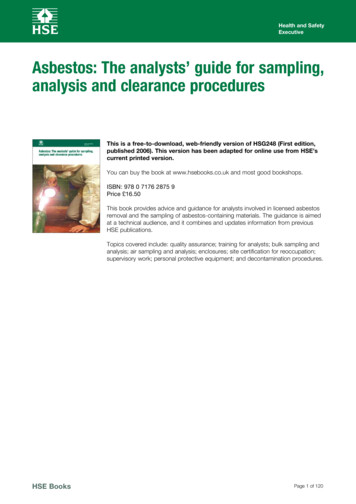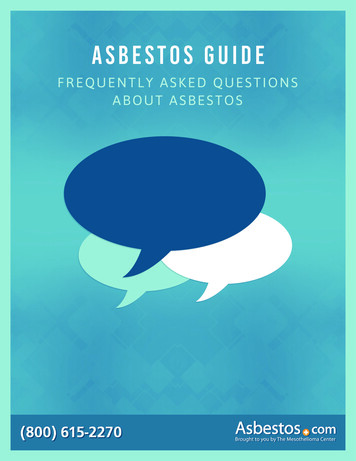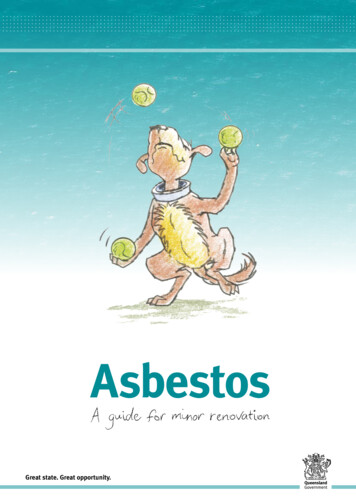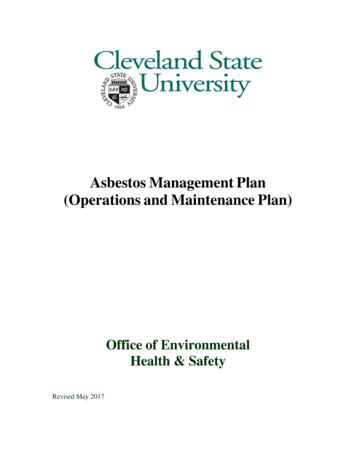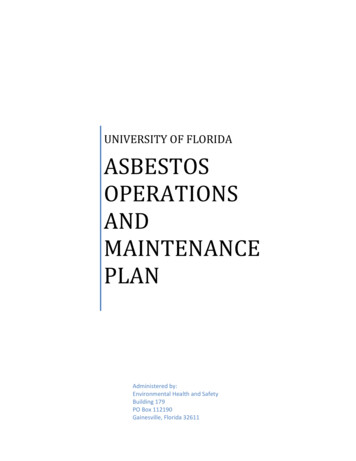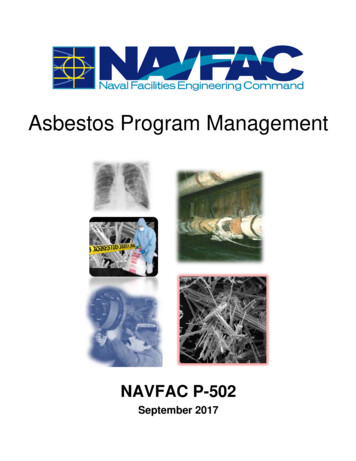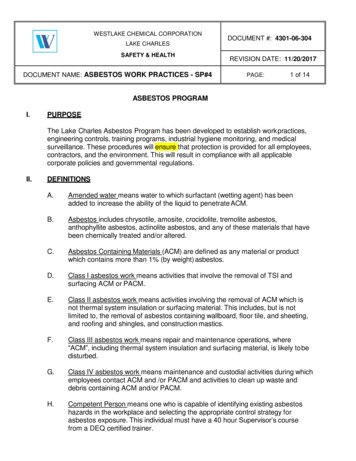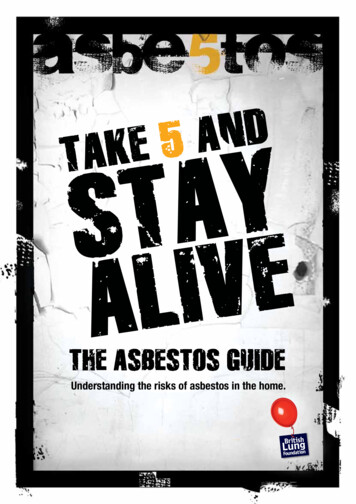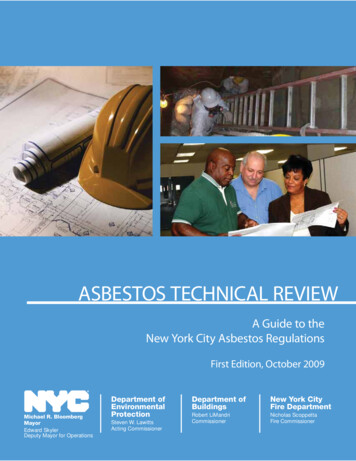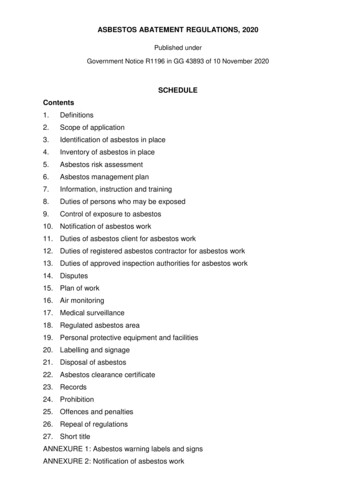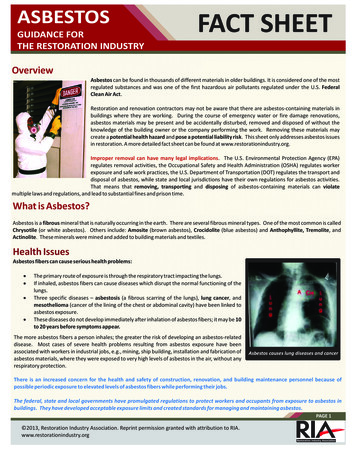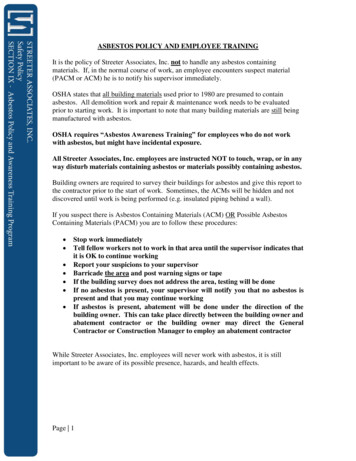
Transcription
ISAN JOSE STATEUNIVERSITYAsbestos Operations and Maintenance ProgramSan José State UniversityOne Washington SquareSan José, CaliforniaFacilities Development and Operations DepartmentEnvironmental Health and SafetyJuly 25, 2012
Asbestos Operations and Maintenance ProgramSAN JOSE STATEEnvironmental Health and SafetyUNIVERSITY1) Purpose and ScopeThe purpose of the Asbestos Operations and Maintenance Program is to protect San José StateUniversity employees, students and visitors from the exposure to asbestos containing materials andthe exposure to asbestos fibers in air.2) Standards, Regulations and Referencesa) California Code of Regulations,Title 8, Subchapter 4. Construction Safety OrdersArticle 4. Dusts, Fumes, Mists, Vapors, and GasesSection §1529. Asbestos.b) California Code of Regulations,Title 8, Subchapter 7. General Industry Safety OrdersSection §3204. Access to Employee Exposure and Medical Records.c) California Code of Regulations,Title 8, Subchapter 7. General Industry Safety OrdersGroup 16. Control of Hazardous SubstancesArticle 107. Dusts, Fumes, Mists, Vapors and GasesSection §5144. Respiratory Protection.d) Managing Asbestos in PlaceHow to Develop and Maintain a Building Asbestos Operations and Maintenance Programhttp://www.epa.gov/asbestos/pubs/management in place.htmlUS Environmental Protection Agency.3) Roles and Responsibilitiesa) The UniversityThe University is committed to and has a duty to provide a safe and healthful work environmentfor all employees, students and visitors from the exposure to asbestos containing materials andasbestos fibers in air.b) Environmental Health and SafetyEnvironmental Health and Safety will i)Establish, implement and maintain the Asbestos Control Plan which is designed to eliminateor minimize employee exposure to asbestos containing materials and asbestos fibers in air.ii) Maintain an Asbestos in Buildings database of buildings with known asbestos containingmaterials.iii) Perform an employee exposure determination and document the findings with thecollaboration of each department’s management.iv) Develop an Asbestos Project Work Permit System to monitor small asbestos removalprojects performed on campus. Work permits are maintained for 3 years.v) Develop and implement campus-wide training requirements and materials. Employeeinformation and training are provided at the time of initial assignment and annuallythereafter.SJSU Asbestos O&M Program 2011-0725.docx2 of 14
Asbestos Operations and Maintenance ProgramSAN JOSE STATEEnvironmental Health and SafetyUNIVERSITYvi) Maintain a record of training given to employees for 3 years.vii) Maintain a record of the results of examinations, medical testing, and follow-up procedures,and the physicians written opinion. Records will be maintained for the duration ofemployment plus 30 years.viii) Audit and review the Asbestos Control Plan annually.c) Department ManagementEach affected Department will i)Collaborate with the Environmental Health and Safety in the employee exposuredetermination process.ii) Provide the time and resources to effectively implement the Asbestos Control Plan foremployees determined to be at risk of exposure to bloodborne pathogens.iii) Enable employees who are at risk of exposure and enrolled in the Asbestos Control Plan toreceive hazard awareness training.iv) Develop and enforce work practices and methods designed to control or eliminate the riskof exposure to asbestos containing materials and asbestos fibers in air.v) Provide the necessary work implements, such as tools, gloves, personal protectiveequipment and containment supplies, to employees.d) Healthcare ProviderThe healthcare provider when authorized will i)Perform pre-placement, termination of employment, and annual periodic medicalmonitoring examinations.ii) Maintain confidential medical records.e) EmployeesEvery employee who is at risk of exposure to asbestos containing materials and asbestos fibersin air and enrolled in the Asbestos Control Plan will i)Receive hazard awareness training on an annual basis.ii) Be provided with the necessary work implements, such as tools, gloves, and personalprotective equipment and containment supplies, to perform their job safely.iii) Be provided information and training in the safe work of asbestos containing materials.iv) Follow the prescribed work practices and methods designed to control or eliminate the riskof exposure to asbestos containing materials and asbestos fibers in air.v) Be provided medical monitoring examinations at the time of job assignment, annuallythereafter and at the termination of the job assignment.vi) Report exposure incidents to the supervisor immediately.4) Program AuditEnvironmental Health and Safety will perform a program audit annually and make improvements tothe Asbestos Control Plan as conditions change.SJSU Asbestos O&M Program 2011-0725.docx3 of 14
Asbestos Operations and Maintenance ProgramEnvironmental Health and SafetySAN JOSE STATEUNIVERSITY5) Document History and ControlThe San José State University Asbestos Operations and Maintenance Program described hereinsupersede all prior written Program documents.Rev #Document Revision HistoryAuthor00Revision No ChangeDavid KrackInitial DocumentEnvironmental Healthand SafetyReviewerDateJuly 25, 201201SJSU Asbestos O&M Program 2011-0725.docx4 of 14
Asbestos Operations and Maintenance ProgramSAN JOSE STATEEnvironmental Health and SafetyUNIVERSITY1) The Asbestos Operations and Maintenance ProgramThe University is committed to and has a duty to provide a safe and healthful work environment forall employees, students and visitors from the exposure to asbestos containing materials andasbestos fibers in air.a) Asbestos Containing Materials in Construction Materials.Asbestos may be present in buildings and is managed in place. It can be classified in one of thefollowing categories.i)Surfacing Material: Examples include ACM sprayed or troweled onto surfaces, such asdecorative plaster on ceilings or acoustical ACM on the underside of concrete slabs ordecking, or fireproofing materials on structural members.ii) Thermal System Insulation: Examples of this material, which is also referred to as TSI,include ACM applied to pipes, boilers, tanks, and ducts to prevent heat loss or gain, orcondensation.iii) Miscellaneous ACM: Examples include asbestos-containing ceiling or floor tiles, textiles, andother components such as asbestos cement panels, asbestos siding and roofing materials,and electrical and sound insulation materials.b) O&M Program Project Types.The O&M program can be divided into four types of projects:i)Those projects that are unlikely to involve any direct contact with ACM.These projects may involve routine cleaning of shelves and counter tops or other surfaces ina building (provided ACM debris is not present). Generally, such activities would not beexpected to disturb ACM.ii) Those that may cause accidental disturbance of ACM.These projects could include maintenance work above a suspended ceiling in an area thatmay have surfacing ACM overhead.iii) Those that involve relatively small disturbances of ACM.These projects—small-scale, short-duration maintenance, repair, or installation projectsinvolving minor disturbances of ACM—include activities such as installation of new lightfixtures on or in an ACM ceiling.A single glove bag operation to remove a small amount of ACM to repair a pipe in a boilerroom is an example of intentional small-scale, short duration disturbance.iv) Larger projects involving more complex procedures for the intentional removal of ACM areconsidered asbestos abatement projects. These require asbestos control and abatementprocedures.2) The Asbestos Control Plan (ACP) is designed to eliminate or minimize exposure to asbestoscontaining materials and asbestos fibers in air. The ACP includes the following key elements:a) Determination of employee exposureb) Implementation of exposure control methods, including:i)Asbestos Program ManagerSJSU Asbestos O&M Program 2011-0725.docx5 of 14
Asbestos Operations and Maintenance ProgramSAN JOSE STATEEnvironmental Health and SafetyUNIVERSITYii) Building Inspectioniii) Develop an O&M Plan(1) Work Permit System(2) Periodic Notice to Building Occupants(3) Asbestos Work Permit Systemc) Asbestos Repair or Abatement Projectsd) Air Clearance Procedures.e) Disposal of Asbestos Containing Materialsf)Employee Information and Training.g) Personal Protective Equipment.h) Information for Occupants.i)Medical Monitoring.j)Recordkeeping.3) Definitionsa) Asbestos includes chrysotile, amosite, crocidolite, tremolite asbestos, anthophyllite asbestos,actinolite asbestos, and any of these minerals that has been chemically treated and/or altered.For purposes of this standard, "asbestos" includes PACM, as defined below.b) Asbestos-containing material (ACM), means any material containing more than one percentasbestos.c) Authorized person means any person authorized by the employer and required by work dutiesto be present in regulated areas.d) Class I asbestos work means activities involving the removal of TSI and surfacing ACM andPACM.e) Class II asbestos work means activities involving the removal of ACM which is not thermalsystem insulation or surfacing material. This includes, but is not limited to, the removal ofasbestos-containing wallboard, floor tile and sheeting, roofing and siding shingles, andconstruction mastics.f)Class III asbestos work means repair and maintenance operations, where "ACM", including TSIand surfacing ACM and PACM, is likely to be disturbed.g) Class IV asbestos work means maintenance and custodial activities during which employeescontact but do not disturb ACM or PACM and activities to clean up dust, waste and debrisresulting from Class I, II, and III activities.h) Disturbance means activities that disrupt the matrix of ACM or PACM, crumble or pulverizeACM or PACM, or generate visible debris from ACM or PACM. Disturbance includes cutting awaysmall amounts of ACM and PACM, no greater than the amount which can be contained in onestandard sized glove bag or waste bag in order to access a building component. In no event shallthe amount of ACM or PACM so disturbed exceed that which can be contained in one glove bagor waste bag which shall not exceed 60 inches in length and width.SJSU Asbestos O&M Program 2011-0725.docx6 of 14
Asbestos Operations and Maintenance ProgramEnvironmental Health and SafetySAN JOSE STATEUNIVERSITYi)Glove bag means an impervious plastic bag-like enclosure affixed around not more than a 60 x60 inch asbestos-containing material, with glove-like appendages through which material andtools may be handled.j)PACM means "presumed asbestos-containing material".k) Presumed Asbestos Containing Material means thermal system insulation and surfacingmaterial found in buildings constructed no later than 1980.l)Regulated area means: an area established by the employer to demarcate areas where Class I,II, and III asbestos work is conducted, and any adjoining area where debris and waste from suchasbestos work accumulate; and a work area within which airborne concentrations of asbestos,exceed or there is a reasonable possibility they may exceed the permissible exposure limit.m) Removal means all operations where ACM and/or PACM is taken out or stripped fromstructures or substrates, and includes demolition operations.n) Renovation means the modifying of any existing structure, or portion thereof.o) Repair means overhauling, rebuilding, reconstructing, or reconditioning of structures orsubstrates, including encapsulation or other repair of ACM or PACM attached to structures orsubstrates.p) Surfacing material means material that is sprayed, troweled-on or otherwise applied to surfaces(such as acoustical plaster on ceilings and fireproofing materials on structural members, or othermaterials on surfaces for acoustical, fireproofing, and other purposes).q) Surfacing ACM means surfacing material which contains more than 1% asbestos.r) Thermal system insulation (TSI) means ACM applied to pipes, fittings, boilers, breeching, tanks,ducts or other structural components to prevent heat loss or gain.s) Thermal system insulation ACM is thermal system insulation which contains more than 1%asbestos.4) Exposure DeterminationsAn exposure determination was made of the University staff positions without regard to the use ofpersonal protective equipment (PPE) by Environmental Health and Safety. It was determined thatthe following class of employees may have an occupational exposure to asbestos containingmaterials and asbestos fibers in air.#DepartmentBuilding LocationJob Title ofEmployees at Risk of ExposureNature of Exposure RiskUtilities Maintenance &Operations WorkersSurfacing MaterialsCarpentersMiscellaneous ACMResponsible Administrator1Facilities Development andOperations DepartmentElectriciansThermal System InsulationHVAC TechniciansMaintenance TechniciansPlumbersPaintersSJSU Asbestos O&M Program 2011-0725.docx7 of 14
Asbestos Operations and Maintenance ProgramEnvironmental Health and SafetySAN JOSE STATEUNIVERSITY#DepartmentBuilding LocationJob Title ofEmployees at Risk of ExposureNature of Exposure RiskMaintenance TechniciansSurfacing MaterialsPlumbersThermal System InsulationElectriciansMiscellaneous ACMResponsible Administrator2Student Housing ServicesCarpenters5) Methods of Implementation and Controla) Asbestos Program ManagerEnvironmental Health and Safety is the Asbestos Program Manager. The Asbestos ProgramManager oversees asbestos-related activities on campus, including inspections, ACM buildinginspection database, work permits for operations and maintenance activities, training andrecord keeping.b) Building InspectionAn initial building inspection was performed to locate and assess the condition of ACM inbuildings on campus. The data is compiled in a database and is maintained by the AsbestosProgram Manager. Additional inspections and assessments may take place during the planningphase of a renovation or repair project in order to confirm the presence or absence of ACMbefore the work begins.c) The Asbestos Work Permit Systemi)The Asbestos Program Manager monitors the work by operations and maintenanceemployees and by other contractors, who might inadvertently disturb ACM during a smallglove bag project.ii) An Asbestos Work Permit from the Asbestos Program Manager (Environmental Health andSafety) is required before the start of the project.iii) The APM will inform the employees or contractor whether the project could disturb ACMand provide any special instructions to make sure the work is done properly.6) Asbestos Repair or Abatement ProjectsRenovations, including remodeling or redecorating, of buildings or replacement of utility systemsincrease the potential for disturbing ACM.a) Before conducting any renovation or remodeling work, the project manager should have theAsbestos Program Manager review asbestos inspection and assessment records to determinewhere ACM may be located, visually re-inspect the area, and evaluate the likelihood that ACMwill be disturbed.b) Any suspect or assumed ACM that could be disturbed during the renovation work should besampled and analyzed to determine whether it contains asbestos, or if the work should becarried out as if the materials did contain asbestos.c) The Asbestos Program Manager should ensure that no new ACM is introduced into the buildingas part of the renovation work.SJSU Asbestos O&M Program 2011-0725.docx8 of 14
Asbestos Operations and Maintenance ProgramSAN JOSE STATEEnvironmental Health and SafetyUNIVERSITYd) If it is determined that ACM should be removed as part of the renovation or repair project andthe amount of ACM is greater than one 60”x60” glove bag, a licensed asbestos remediationcontractor will perform the work.7) Air Clearance Procedures.a) Proper completion of the ACM removal is evaluated with an air clearance procedure.b) The Asbestos Program Manager will ensure that clearance air samples are collected for smallrepair and remediation projects. Air clearance samples for larger remediation projects arebundled with the overall contract provisions and performed by an outside contract service.c) AHERA clearance protocols (TEM - Transmission electron microscope analysis) are not requiredfor abatement actions in commercial buildings or in buildings of higher education. AHERAprotocols may be used as a reference.d) NIOSH Method 7400A (PCM – Phase Contrast Microscopy) for particulate in air may be used todetermine if the space is ready for re-occupancy.8) Disposal of Asbestos Containing Materialsa) Debris from small ACM operations and maintenance projects is collected, double bagged in 6 milplastic, wetted, labeled and taken to Industrial Studies Building Room 127 for disposal.b) The waste bag will be labeled as follows:DANGER CONTAINS ASBESTOS FIBERS AVOID CREATING DUST CANCER AND LUNG DISEASEHAZARDc) Environmental Health and Safety will coordinate for the disposal with a licensed transport anddisposal contractor.9) Employee Information and Training.a) Awareness TrainingThis training is for maintenance and custodial staff involved in cleaning and minor maintenancetasks where ACM may be accidentally disturbed.Awareness Training is one hour in duration and includes such topics as:i)Background information on asbestosii) Health effects of asbestosiii) Worker protection programsiv) Locations of ACM and Presumed Asbestos-Containing Material (PACM) in the buildingv) Recognition of ACM and PACM damage and deterioration.vi) Proper response to fiber release episodes.b) Operations & Maintenance and Abatement Worker TrainingThis training is for workers who may conduct asbestos abatement activities.This work involves direct, intentional contact with ACM. The recognized abatement workertraining courses approved by EPA or state regulations for schools and for public and commercialSJSU Asbestos O&M Program 2011-0725.docx9 of 14
Asbestos Operations and Maintenance ProgramSAN JOSE STATEEnvironmental Health and SafetyUNIVERSITYbuildings, are required to conduct such work. The EPA regulations require 40 hours of trainingfor employees participating in asbestos abatement.Abatement worker training addresses specialized topics, such as:i)Pre-asbestos abatement work activitiesii) Work area preparationiii) Establishing decontamination unitsiv) Personal protection, including respirator selection, use, fit-testing, and protective clothingv) Worker decontamination proceduresvi) Safety considerations in the abatement work areavii) A series of practical hands-on exercisesviii) Proper handling and disposal of ACM wastes.c) Refresher Trainingi)Employees who have occupational exposure to asbestos containing materials and asbestosfibers in air receive annual training coordinated by Environmental Health and Safety.ii) Awareness Training which consists of a one-hour presentation is given each year to custodialand maintenance workers.iii) Operations & Maintenance Worker and Abatement Worker Training consist of an eight hourpresentation and is given annually.d) Training materials are available at the Environmental Health and Safety office located in theIndustrial Studies Building, Room 134 B.10) Personal Protective Equipment.a) PPE is obtained through the first line supervisor of the affected department and is provided toemployees at no cost.b) The types of PPE available to employees include gloves, eye protection, outer garments asnecessary and respiratory protection.c) Respiratory Protectioni)Filtering facepiece respirators must not be used against asbestos fibers.ii) Only HEPA filters for powered and non-powered air-purifying respirators are used.iii) A tight fitting powered, air- purifying respirator may be used in lieu of any negative-pressurerespirator selected whenever an employee chooses to use this type of respirator.11) Information for Occupants.a) Building occupants will be notified on an annual basis that asbestos may be present in buildingconstruction materials and that fibers may be released if the ACM is disturbed inadvertently.b) The information given to building occupants and workers may address the following points tothe extent they reflect building conditions:SJSU Asbestos O&M Program 2011-0725.docx10 of 14
Asbestos Operations and Maintenance ProgramSAN JOSE STATEEnvironmental Health and SafetyUNIVERSITYi)ACM has been found in the building and is located in areas where the material could bedisturbed.ii) The condition of the ACM, and the response that is appropriate for that condition.iii) Asbestos only presents a health risk when fibers become airborne and are inhaled.iv) The mere presence of intact ACM may not represent a health risk.v) The ACM is found in the following locations (e.g., ceilings, walls, above suspended ceilings,on columns, on pipes).vi) Do not disturb the ACM (e.g., do not push furniture against the ACM, do not damagethermal system insulation (TSI)).vii) Report any evidence of disturbance or damage of ACM to the Director of EnvironmentalHealth and Safety.viii) Report any dust or debris that might come from the ACM or suspect ACM, any change in thecondition of the ACM, or any improper action relative to ACM of building personnel to theDirector of Environmental Health and Safety.ix) Cleaning and maintenance personnel are taking special precautions during their work toproperly clean up any asbestos debris and to avoid disturbing ACM.x) All ACM is inspected periodically and additional measures will be taken if needed to protectthe health of building occupants.12) Medical Monitoring.a) Employees who perform asbestos Class I, II or III repair or renovation work as defined by theDivision of Occupational Safety and Health are enrolled in the Medical Monitoring Program.Medical examinations are made available to employees i)Prior to assignment of the employee to an area where negative- pressure respirators areworn;ii) At least annually thereafter.iii) At the termination of employment for any employee who has been exposed to airborneconcentrations of asbestos at or above the permissible exposure limit and/or excursionlimit. The medical examination shall be given within 30 calendar days before or after thedate of termination of employment.b) Medical examinations will include i)A medical and work history with special emphasis directed to the pulmonary,cardiovascular, and gastrointestinal systems.ii) Completion of the Mandatory Medical Questionnaire as defined by the Division ofOccupational Safety and Health in Title 8, Construction Safety Orders, Section §1529.Asbestos, Appendix D.iii) A physical examination directed to the pulmonary and gastrointestinal systems, including achest roentgenogram and pulmonary function tests of forced vital capacity (FVC) and forcedexpiratory volume at one second (FEV(1)).SJSU Asbestos O&M Program 2011-0725.docx11 of 14
Asbestos Operations and Maintenance ProgramSAN JOSE STATEEnvironmental Health and SafetyUNIVERSITY13) Recordkeeping.a) Training Recordsi)A record is created for each employee upon completion of training. These records will bekept for at least three years at San José State University, Environmental Health and Safety,Industrial Studies Building, Room 134 B.ii) The training records include:(1) The dates of the training sessions.(2) The contents or a summary of the training sessions.(3) The names and qualifications of persons conducting the training.(4) The names and job titles of all persons attending the training sessions.iii) Employee training records are provided upon request to the employee or the employee’sauthorized representative within 15 working days. Such requests should be addressed toSan José State University, Environmental Health and Safety.b) Medical Recordsi)Medical records are maintained by Environmental Health and Safety for each employee withoccupational exposure to ACM and asbestos fibers in air in accordance with California Codeof Regulations, Title 8, §3204, “Access to Employee Exposure and Medical Records”.ii) These confidential records are kept for at least the duration of employment plus 30 years.iii) Employee medical records are provided upon request of the employee or to anyone havingwritten consent of the employee within 15 working days.c) Asbestos in Buildings Assessment Recordsi)The Asbestos in Buildings Assessment database is maintained by Environmental Health andSafety in accordance with California Code of Regulations, Title 8, §3204, “Access toEmployee Exposure and Medical Records”.ii) The database is amended as new information is developed from repair and renovationprojects.iii) Environmental Health and Safety will make the information within the database available tomaintenance employees who made inadvertently disturb ACM.d) Asbestos Work Permits for Small Projectsi)Asbestos Work Permits for small projects are issued and maintained by EnvironmentalHealth and Safety.ii) Asbestos Work Permits are maintained for three years.EndSJSU Asbestos O&M Program 2011-0725.docx12 of 14
Asbestos Operations and Maintenance ProgramEnvironmental Health and SafetySAN JOSE STATEUNIVERSITYASBESTOS WORK PERMIT APPLICATIONAsbestos removal/disturbance work may be performed by trained and authorized employees of SanJose’ State University. “Trained” means that the employee has successfully completed a Cal/OSHAaccredited course for Class I, II, III and IV asbestos work and is enrolled in the SJSU Environmental Healthand Safety Department annual refresher training program. Asbestos removal is limited to 100 sq ftand/or the amount that will fill a 60” x 60” bag.SJSU PROJECT / WORK ORDER NUMBER:1. Building Name:2. Room:3. ACM Description:(Ceiling, Flooring, Wall, RoofingMaterials, Thermal Piping Insulation)4. Start Date and Time:5. Planned CompletionDate and Time:6. Project Staffing:1st Worker (Project Leader):7. Project Description:(ACM removal description, ACM volume – bags, sq ft)2nd Worker:3rd Worker:8. Work Plan – Containment:Wet MethodsMini Enclosure w/Neg AirGlove BagDecon HEPA VACDecon Wipe-Down9. Work Plan – PPE:HEPA CartridgeRespiratorTyvek Suit with HoodShoe Covers10. Work Plan – Air Monitoring:Personal Air SamplesArea Clearance Air Samples11. Other Work Practices:Asbestos Hazard Signs PostedWaste Taken to Storage Location (IS 127)Special Tools & Equipment12. Permit RequesterTelephoneDate Submitted13. Work Supervisor ReviewDan CoxTelephoneDate Reviewed14. EnvironmentalHealth & SafetyDavid Krack, PrimaryJohn Skyberg, AlternateCell – 510-209-5541Office – 408-924-1978Home – 510-651-5180Home FAX – 510-5730432Date Granted/DeniedPermit Granted:Permit Denied:Signature:[NOTE: Approval is required from the appropriate manager for Overtime Work]SJSU Asbestos O&M Program 2011-0725.docx13 of 14
Asbestos Operations and Maintenance ProgramEnvironmental Health and SafetySAN JOSE STATEUNIVERSITYASBESTOS CONTROL WORK PRACTICESAsbestos removal/disturbance work performed by trained and authorized San Jose’ State Universityemployees will follow the standard asbestos control work practices as detailed below.As work is performed, check-off the completed tasks.SJSU PROJECT / WORK ORDER NUMBER: I# CompletedTasksIAsbestos Control Work Practices1Notify the SJSU Environmental Health and Safety office in IS Building 134B bycompleting the ASBESTOS WORK PERMIT APPLICATION prior to the project start.2Review in-house abatement procedures for removal/disturbance of asbestoscontaining materials.3Collect personal air monitoring equipment from Environmental Health and Safetyoffice.4Demarcate and place Asbestos Hazard signs to restrict access to work area.5Shut off or isolate ventilation systems.Note – Use Work Control shut down procedures as appropriate6Ensure that Personal Protective Equipment is provided and worn.(HEPA Cartridge Respirators, disposable coveralls, head cover, shoe covers, andgloves).7Ensure that all assigned personnel are currently qualified and enrolled in theSJSU Environmental Health and Safety Asbestos Work Training Program.8Use wet methods, mini-enclosures, glove bags, drop cloths and / or partitions forcontrolling dust.9Place all asbestos waste in two – 6 mil plastic bags labeled with Asbestos HazardWarning labels and the generator’s name and address. Wet contents withamended water.10Wet - wipe all surfaces and tools and equipment at the end of the project.11Deliver all asbestos related tools, equipment, and unused supplies toIndustrial Studies Room 127 for storage.12Deliver all bagged and wetted waste asbestos containing materials toIndustrial Studies Room 127 for storage prior to removal to a regulated wastedisposal site.13Return personal and area air monitoring equipment and sample cassettes toEnvironmental Health and Safety for laboratory analysis and record keeping.Return this completed form at the end of the project to SJSU Environmental Health and Safety officelocated in Industrial Studies Building Room 134BProject Leader Name and Signature:SJSU Asbestos O&M Program 2011-0725.docxDate and Time Project Completed:14 of 14
other components such as asbestos cement panels, asbestos siding and roofing materials, . A single glove bag operation to remove a small amount of ACM to repair a pipe in a boiler room is an example of intentional small-scale, short duration disturbance. iv) Larger projects involving more complex procedures for the intentional removal of ACM .
